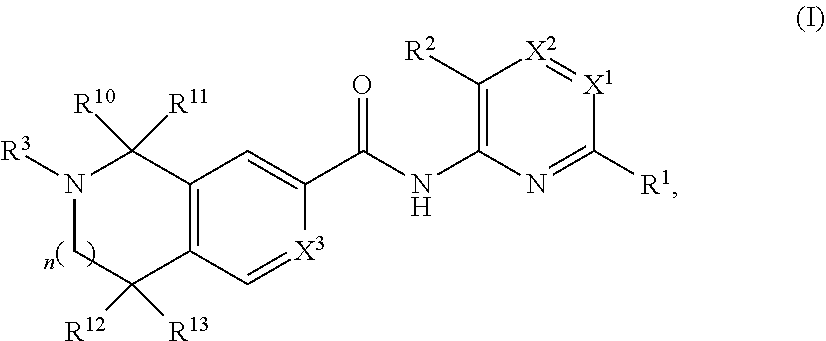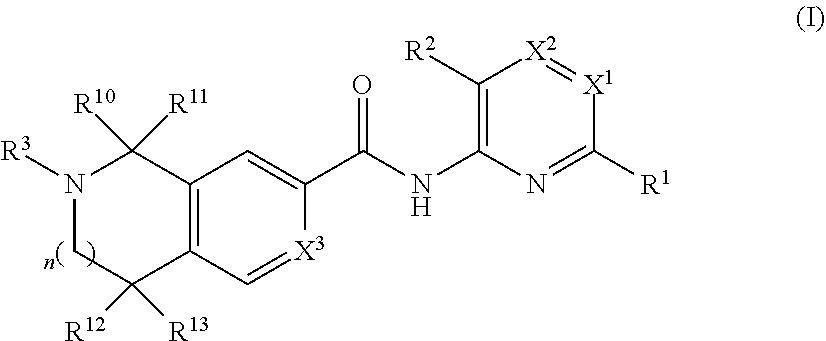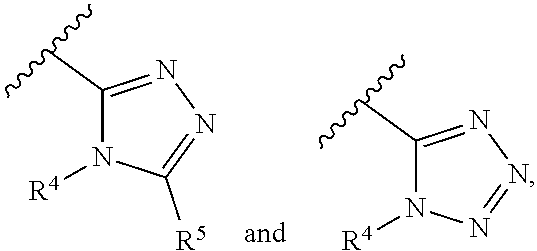Apoptosis signal-regulating kinase 1 inhibitors and methods of use thereof
a signal-regulating kinase and kinase technology, applied in the field of compounds and pharmaceutical compositions useful as ask1 inhibitors, can solve problems such as fat accumulation and fatty acid oxidation, and achieve the effect of prevention or treatmen
- Summary
- Abstract
- Description
- Claims
- Application Information
AI Technical Summary
Benefits of technology
Problems solved by technology
Method used
Image
Examples
example 1
sopropyl-4H-1,2,4-triazol-3-yl)pyridin-2-yl)-6-pivaloyl-5,6,7,8-tetrahydro-2,6-naphthyridine-3-carboxamide
[0245]
Step 1. Synthesis of 2-(tert-butyl) 7-ethyl 3,4-dihydro-2,6-naphthyridine-2,7(1H)-dicarboxylate
[0246]
[0247]A mixture of tert-butyl 7-chloro-3,4-dihydro-2,6-naphthyridine-2(1H)-carboxylate (3.0 g, 11.16 mmol), Pd(OAc)2 (0.251 g, 1.12 mmol), 1,3-bis(diphenylphosphino)propane (0.921 g, 2.23 mmol), and Et3N (4.67 ml, 33.5 mmol) in DMF (29.8 ml) / EtOH (14.9 ml) were stirred under a balloon of CO at 80° C. overnight. The reaction was quenched with HzO / brine and diluted with EtOAc. The layers were separated and the organic layer was washed with H2O / brine (2×). The organic layer was dried (MgSO4), filtered, and concentrated under reduced pressure. The resultant brown gum was purified by column chromatography eluting with hexanes / EtOAc (0% / EtOAc→75% EtOAc) to afford 2-(tert-butyl) 7-ethyl 3,4-dihydro-2,6-naphthyridine-2,7(1H)-dicarboxylate (2.17 g, 7.08 mmol, 64% yield) as a pale ye...
example 2
methylsulfamoyl)-N-(6-(4-isopropyl-4H-1,2,4-triazol-3-yl)pyridin-2-yl)-5,6,7,8-tetrahydro-2,6-naphthyridine-3-carboxamide
[0255]
Representative procedure for sulfonyl urea formation.
[0256]Dimethylsulfamoyl chloride (16.1 μl, 21.5 mg, 0.15 mmol) was added dropwise to a solution of N-(6-(4-isopropyl-4H-1,2,4-triazol-3-yl)pyridin-2-yl)-5,6,7,8-tetrahydro-2,6-naphthyridine-3-carboxamide hydrochloride (40 mg, 0.10 mmol) and Et3N (70 μL, 50 mg, 0.50 mmol) in CH2Cl2 (1.0 mL) at 0° C. The cold bath was removed and the reaction was stirred 1 h at it. The reaction was quenched with sat. NaHCO3 and diluted with CH2Cl2. The layers were separated and the aqueous layer was extracted with CH2Cl2 (2×). The combined organic layers were washed with brine, dried (MgSO4), filtered, and concentrated under reduced pressure. The resultant yellow gum was purified by column chromatography eluting with CH2Cl2 / MeOH (0% MeOH→8% MeOH) to afford 6-(N,N-dimethylsulfamoyl)-N-(6-(4-isopropyl-4H-1,2,4-triazol-3-yl)pyr...
example 3
l-N-(6-(4-isopropyl-4H-1,2,4-triazol-3-yl)pyridin-2-yl)-5,6,7,8-tetrahydro-2,6-naphthyridine-3-carboxamide
[0257]
[0258]Representative procedure for reductive alkylation.
[0259]Sodium triacetoxyborohydride (106 mg, 0.50 mmol) was added to a solution of N-(6-(4-isopropyl-4H-1,2,4-triazol-3-yl)pyridin-2-yl)-5,6,7,8-tetrahydro-2,6-naphthyridine-3-carboxamide hydrochloride (40 mg, 0.10 mmol) and isobutyraldehyde (46 μL, 36 mg, 0.50 mmol) in 1,2-DCE (1.3 mL) and the reaction was stirred overnight. The reaction was quenched with sat. NaHCO3 and diluted with CH2Cl2. The layers were separated and the aqueous layer was extracted with DCM (2×). The combined organic layers were dried (MgSO4), filtered, and concentrated under reduced pressure. The resultant yellow residue was purified by column chromatography eluting with DCM / MeOH (0% MeOH→20% MeOH) to afford 6-isobutyl-N-(6-(4-isopropyl-4H-1,2,4-triazol-3-yl)pyridin-2-yl)-5,6,7,8-tetrahydro-2,6-naphthyridine-3-carboxamide (16.3 mg, 0.039 mmol, 39...
PUM
 Login to View More
Login to View More Abstract
Description
Claims
Application Information
 Login to View More
Login to View More - R&D
- Intellectual Property
- Life Sciences
- Materials
- Tech Scout
- Unparalleled Data Quality
- Higher Quality Content
- 60% Fewer Hallucinations
Browse by: Latest US Patents, China's latest patents, Technical Efficacy Thesaurus, Application Domain, Technology Topic, Popular Technical Reports.
© 2025 PatSnap. All rights reserved.Legal|Privacy policy|Modern Slavery Act Transparency Statement|Sitemap|About US| Contact US: help@patsnap.com



